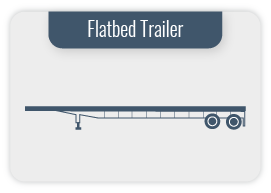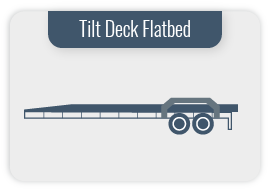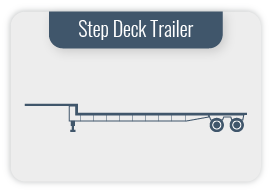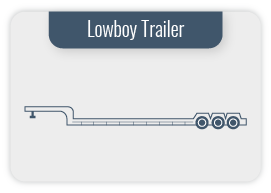

Transporting goods on a flatbed trailer is a mode of transportation that utilizes a specialized type of trailer, also known as a flatbed, lowboy, or flatbed trailer.
A flatbed trailer is the most versatile type of commercial transport, often referred to as the Swiss army knife of trailers. With proper cargo measurement, space utilization, and securement, you can transport nearly any type of commodity using a flatbed.
Unlike enclosed trailers, a flatbed has an open surface, meaning it lacks sides and a roof. This design allows for the transportation of large and heavy items that typically cannot fit inside a standard closed truck.
Here, we will tell you everything you need to know about flatbed trailers and how to maximize their advantages for your transportation business.
Key Features of a Flatbed
If you’re considering purchasing a truck and are unsure of the best option, evaluate the key features of a flatbed before making any decisions:
Versatility
A flatbed is versatile and capable of transporting different types of cargo, including those that are large, heavy, or irregularly shaped.
Loading and Unloading
Loading and unloading on a flatbed are relatively simple tasks, provided you don’t require tarps or covers due to the absence of walls and a roof. Additionally, the use of cranes and forklifts is facilitated.
Cargo Securement
Cargo on a flatbed must be properly secured using straps, chains, or other types of restraints to prevent shifting or falling during transit. It’s important to note that in 90% of cases, the driver is responsible for securing this cargo.
Importance in Various Industries
Flatbed trailers play a crucial role in several industries, including construction, assembly, forestry projects, drayage, and energy. They make it easier to transport large tools and some oversized raw materials from one location to another.
Types of Flatbed Trailers
There are various types of flatbed trailers, each designed to meet specific transportation needs. Here are some of the most common types:
- Standard Flatbed: This is the classic flatbed trailer, consisting of a flat, open platform for transporting large and heavy cargo, up to 8.5 feet wide and 53 or 48 feet long, with a 4-foot overhang that can exceed the standard limit.

- Extendable Flatbed (RGN): These trailers can be extended in length to accommodate longer and heavier loads. They are extremely useful when transporting objects that are too long for a standard trailer and require permits for moving such heavy cargo.

- Tilt Deck Flatbed: These trailers have the capability to tilt hydraulically to facilitate loading and unloading by allowing cargo to slide onto or off the platform at an inclined angle.

- Conestoga (Auto Tarping): Similar to a standard flatbed but equipped with a curtain system that simulates the walls and roof of an enclosed trailer.

- Step Deck: A variation of the standard flatbed with a lower deck height, allowing it to accommodate taller cargo that exceeds standard height limits.

- Lowboy or Low-Bed: These trailers have a minimal deck height just after the gooseneck and before the wheels, allowing them to carry legal loads of up to 12 feet in height, a capability other trailers do not have. Lowboys are used for transporting heavy equipment like bulldozers and large industrial machinery.

What Types of Cargo Are Transported on Flatbed Trailers?
As mentioned earlier, flatbed trailers are quite versatile. However, it’s essential to ensure that the cargo is well-secured to comply with transportation regulations. Some of the most common types of cargo transported on flatbed trailers include:
Construction Materials: Bricks, steel beams, concrete, pipes, drywall panels.
Heavy Machinery: Agricultural equipment such as tractors and harvesters, as well as other tools like excavators, backhoes, front-end loaders, and cranes.
Vehicles: Cars, motorcycles, recreational vehicles, trucks, and other vehicles that cannot be transported in enclosed trailers.
Metal Products: Metal sheets, steel bars, and steel coils.
Bulk Materials: Sand, gravel, soil, rocks, as long as they are in bags.
Industrial Equipment: Boilers, generators, and industrial machinery.
Regulatory Permits for Flatbeds
Flatbed trailers are subject to regulations to ensure road safety. These regulations pertain to weight limits, cargo safety, proper lighting, and signaling for compliance with transportation laws.
Oversize and Overweight Permits:
A flatbed truck must obtain an oversize permit when the load exceeds the standard dimension. An overweight permit is required when the cargo surpasses the standard weight limit stipulated for each type of trailer. The validity of these permits can vary between 24, 48, 72 hours, or even annual permits. Prices depend on the route.
Remember the importance of handling the permit application process with professionals in trucking permits. This will save you time and prevent potential errors in form completion and documentation.
Recommendations form a Flatbed Expert:
There are different types of accessories that should be kept as a personal kit because you may need them at any time, and they will help you protect and secure the cargo, ensuring your customers that the merchandise will arrive in good condition. Daniel Restrepo, a Flatbed Specialist shares some recommendations.
- Straps or Tie-Downs
It is also recommended to have a good quantity of tie-down straps for securing your cargo, at least 12, as some delicate cargo cannot be tied down with rigid materials like chains but still requires strong security. This ensures access to a wide range of loads and prevents surprises.
- Chains:
Chains serve a similar purpose as straps but are capable of withstanding greater weight and abrasion from materials. They are often needed for transporting damaged cars, motorcycles, logs, cement materials, and other items with sharp edges. Don’t forget binders, which provide support and security to the cargo.
- V-Boards or Edge Protectors:
These small accessories, typically made of plastic or rubber, protect the corners of the cargo from being scratched or torn by the pressure of chains or straps. They are especially useful when transporting boxes or palletized materials.
- Dunnage or 4x4s:
These are wooden blocks used to separate or limit the movement of cargo, serving as stops to prevent cargo from shifting. They can be used horizontally, vertically, or transversely.
Flatbeds are a specialized transportation method that provides the necessary flexibility for carrying large and heavy loads. To do so, careful planning and proper cargo securing are required. Prioritize obtaining commercial insurance from an experienced and reputable agency in the market; this will save you headaches in the future.














